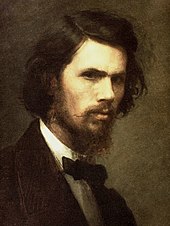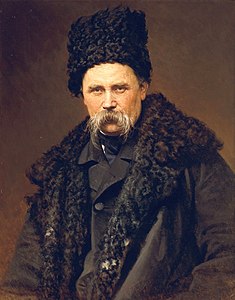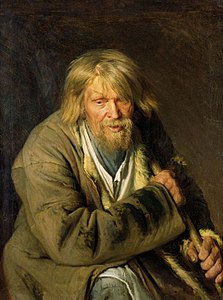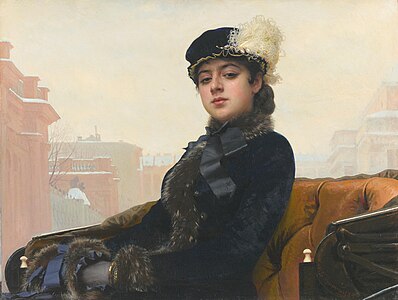Ivan Kramskoi
This article needs additional citations for verification. (June 2021) |
Ivan Kramskoi | |
|---|---|
| Иван Крамской | |
 | |
| Born | 27 May [O.S. 8 June] 1837 Ostrogozhsk, Voronezh Governorate, Russia |
| Died | 5 April 1887 (aged 49) St. Petersburg, Russia |
| Resting place | Tikhvin Cemetery, St. Petersburg |
| Education | |
| Alma mater | Imperial Academy of Arts (1863) |
| Notable work | The Mermaids (1871) Christ in the Desert (1872) Portrait of an Unknown Woman (1883) |
| Movement | Realism, Peredvizhniki |
| Patron(s) | Pavel Tretyakov |
Ivan Nikolayevich Kramskoi[a] (Russian: Иван Николаевич Крамской; 8 June [O.S. 27 May] 1837 – 5 April [O.S. 24 March] 1887) was a Russian Realist painter and art critic.[1] He was an intellectual leader of the art movement known as the Peredvizhniki between 1860 and 1880.
Life
[edit]
Kramskoi came from an impoverished petit-bourgeois family. From 1857 to 1863 he studied at the St. Petersburg Academy of Arts; he reacted against academic art and was an initiator of the "Revolt of the Fourteen" which ended with the expulsion from the Academy of a group of its graduates, who organized the Artel of Artists ("Артель художников").
Influenced by the ideas of the Russian revolutionary democrats, Kramskoi asserted the high public duty of the artist, principles of realism, and the moral substance and nationality of art. He became one of the main founders and ideologists of the Company of Itinerant Art Exhibitions (or Peredvizhniki). In 1863–1868, he taught at the drawing school of a society for the promotion of applied arts. In 1871, ten years after Taras Shevchenko's death, Kramskoi created a portrait of the poet that became widely popular.[2] He created a gallery of portraits of important Russian writers, scientists, artists and public figures (Lev Nikolaevich Tolstoy, 1873, Ivan Shishkin, 1873, Pavel Mikhailovich Tretyakov, 1876, Mikhail Saltykov-Shchedrin, 1879, Sergei Botkin, 1880) in which expressive simplicity of composition and clarity of depiction emphasize profound psychological elements of character. Kramskoi's democratic ideals found their brightest expression in his portraits of peasants, which portrayed a wealth of character-details in representatives of the common people.
In one of Kramskoi's most well known paintings, Christ in the Desert (1872, Tretyakov gallery), he continued Alexander Ivanov's humanistic tradition by treating a religious subject in moral–philosophical terms. He imbued his image of Christ with dramatic experiences in a deeply psychological and vital interpretation, evoking the idea of his heroic self-sacrifice.
Aspiring to expand the ideological expressiveness of his images, Kramskoi created art that existed on the cusp of portraiture and genre-painting ("Nekrasov during the period of 'Last songs,'" 1877–78; "Unknown Woman," 1883; "Inconsolable grief," 1884; all in Tretyakov gallery). These paintings disclose their subjects' complex and sincere emotions, their personalities and fates. The orientation of Kramskoi's art, his acute critical judgments about it, and his persistent quest for objective public criteria for the evaluation of art exerted an essential influence on the development of realist art and aesthetics in Russia in the last third of the nineteenth century.
Kramskoi was considered an eccentric for giving his works to customers in expensive frames and not charging money for it.[3] He died from an aortic aneurysm while working at his easel, aged only forty-nine.
Gallery
[edit]-
The Mermaids, 1871
-
Taras Shevchenko, 1871, after the 1859 photograph by Andrey Denyer
-
Old man with a crutch, 1872
-
Christ in the Desert, 1872
-
Leo Tolstoy, 1873
-
Pavel Tretyakov, 1876
-
Ivan Shishkin, 1880
-
Maria Feodorovna, 1880s
-
Portrait of a woman reading, 1881
-
Mina Moiseyev, 1882
-
Vladimir Solovyov, 1885
-
Alexander III, 1886
Notes
[edit]- ^ Also spelled Kramskoy, as in Valkenier 1996.
References
[edit]- ^ Chilvers, Ian (2015). The Oxford Dictionary of Art and Artists. Oxford University Press. p. 335. ISBN 978-0-19-953294-0.
- ^ Rozdobudko, Ihor. "Іван Крамський (1837–1887) – український художник зі Східної Слобожанщини". radiosvoboda.org.
- ^ Apresyan, A. (2020-01-25). "5 eccentricities of great Russian painters". Russia Beyond the Headlines. Retrieved 2020-02-19.
Publications
[edit]- Kramskoi, Ivan N.; et al. (1888). Suvorin, Aleksey S. and Stasov, Vladimir V. (eds.). Иван Николаевич Крамской. Его жизнь, переписка и художественно-критические статьи, 1837–1887 (in Russian). Saint Petersburg: Suvorin Typography. OCLC 568434544, listed in Freitag 1997, p. 207, no. 6304.
{{cite book}}: CS1 maint: postscript (link) - Kramskoi, Ivan N. (1965–1966). Goldstein, Sofya N. [in Russian] (ed.). Крамской: Письма. Статьи (2 vols.) (in Russian). Moscow: Iskusstvo.
Further reading
[edit]- Goldstein, Sofya N. (1965). Иван Николаевич Крамской (in Russian). Moscow: Iskusstvo. OCLC 7262671, listed in Freitag 1997, p. 207, no. 6299.
{{cite book}}: CS1 maint: postscript (link) - Freitag, Wolfgang M. (1997) [1985]. Art Books: A Basic Bibliography of Monographs on Artists (2nd ed.). New York, London: Garland. p. 207, entries nos. 6298–6304. ISBN 0-8240-3326-4. LCCN 96028425.
- Grachyova, Svetlana M. [in Russian] (2010). "Крамской Иван Николаевич". In Osipov, Yury S. (ed.). Great Russian Encyclopedia (in Russian). Vol. 15. Moscow: Bolshaya Rossiyskaya Entsiklopediya. p. 576. ISBN 978-5-85270-346-0. Archived from the original on January 23, 2023.
- Tsomakion, Anna I. (1995) [1891]. "Крамской". In Stukalin, Evgeniy V. (ed.). Иванов. Федотов. Перов. Крамской (collected biographies). Жизнь замечательных людей: Биографическая библиотека Флорентия Павленкова (in Russian). St. Petersburg: LIO Redaktor. pp. 205–278. ISBN 5-7058-0245-5.
- Valkenier, Elizabeth K. (1996). "Kramskoy, Ivan (Nikolayevich)". In Turner, Jane (ed.). The Dictionary of Art. Vol. 18. New York: Grove's Dictionaries. pp. 438–439. ISBN 1-884446-00-0. LCCN 96013628. OCLC 1033666240 – via the Internet Archive.
External links
[edit]- Ivan Kramskoi at the Russian Academy of Arts' official website (in Russian)
- Ivan Kramskoi's gallery and biography
- Ivan Kramskoi Gallery at MuseumSyndicate Archived 2015-09-12 at the Wayback Machine
- Imperial Academy of Arts alumni
- 1837 births
- 1887 deaths
- People from Ostrogozhsky District
- People from Ostrogozhsky Uyezd
- Peredvizhniki
- Male painters from the Russian Empire
- Orientalist painters from the Russian Empire
- 19th-century painters from the Russian Empire
- Burials at Tikhvin Cemetery
- 19th-century male artists from the Russian Empire













